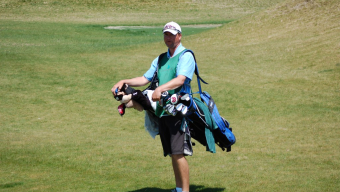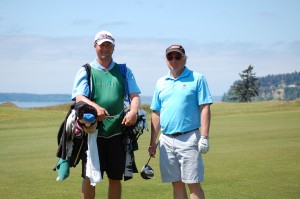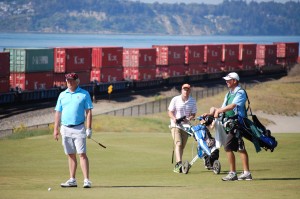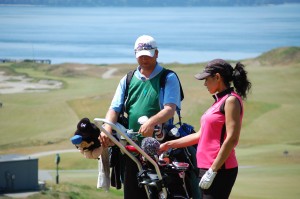UNIVERSITY PLACE, Wa. – One of the many cool things about Chambers Bay, site of the U.S. Amateur in 2010, the 87th Washington State Amateur this year, and the U.S. Open in 2015, is the way the scenic links golf course embraces one of the oldest traditions of the game – the caddie.
Chambers Bay general manager Matt Allen is a former caddie, so it’s no coincidence that his last two jobs, at Bandon Dunes on the Oregon coast and his current one, are among the few public courses in the Northwest with caddies.
Allen is from the old school when it comes to bag-toters.
“I think, because of my background, the caddie program means a lot,” Allen said. “In my nine years at Bandon, we worked really hard, as we have here, on the caddie program.”
It’s called give-back as Allen received a Chick Evans Caddie Sch0larship at the University of Oregon. He has been in the golf business ever since.
Whereas an estimated 75 percent of the players at Bandon Dunes used caddies when Allen was there, he said that on an annual basis at Chambers Bay, “probably 25 percent of the bags going on-course are being carried by a caddie.”
“It’s just part of links golf,” he added. “You know, walking and using a caddie who can help you visualize some of the lengths of the shots that are not immediately apparent to those people who play this course for the first time.”
Figuring out the subtelties of the Chambers Bay greens requires an expert in twists and turns, speed and direction.
Though records are unclear, historians believe that Mary, Queen of Scots, came up with the term “caddie” in the late 16th century. She grew up in France where military cadets carried golf clubs for royalty. It is possible that Mary brought the custom to Scotland, where the term evolved into the word “caddie.”
For some peculiar reason, the word also is spelled “caddy” as in “Caddyshack” the movie.
Back in the day when there was no such thing as a motorized golf cart, both public and private courses had caddies available to the golfers. It was a great way for the youth of the world to learn how to play the game. Many of the caddies, in fact, went on to become successful professional golfers.
I have discovered that the older you get, the more difficult it becomes to lug or even pull a golf bag more than 6,500 yards, the overall distance — depending on how straight you hit the ball. “Military golf” (left-right-left-right) is not recommended, especially when the caddie is toting two bags — one belonging to a player who tends to go right and the other belonging to a player that has a tendency to go left.
As 60-something-year-old golfers familiar with the left-to-right routine, my golferswest.com colleague Bob Sherwin and I decided to use a caddie during a recent media outing at Chambers Bay. The only other time I used a caddie was several years ago at Pebble Beach Golf Links with my son, Scott, and it helped our scores.
Bryan Pierce, an assistant caddie master, assigned us one of his most experienced caddies. Chris Ming has been toting bags and giving good advice to players of all shapes, sizes, nationalities and talent levels since Chambers Bay opened in June 2007.
Now 40 years old and still dreaming of playing on one of the PGA Tours (he’s been to 14 “Q” schools so far, missing the finals by two shots one time and one shot the following year), Chris said he has packed at least 1,000 sets of golf clubs during his six years at the facility. That’s a lot of burned calories and “I can’t believe what I just saw” shots.
According to my Google research, a caddie’s job is to make the game of golf easier and more enjoyable by managing the golfer’s equipment, assisting around the green, especially on the putting surface. Ming was all of that – and more – during our 4 ½ hour round that “featured” 12 pars but no birdies or better. There were far too many double- and triple-bogeys to mention, so I won’t.
The closest any of us came to a birdie was on the par-5 13th, when John Hughes, Bob’s son-in-law, reached the green in two, leaving him with a 10-foot eagle putt. Caddie Chris read the putt and passed the information along to John: “Hit it two balls left of the hole.”
John’s eagle putt was at least four balls left of the hole, and about 6 feet too long. His birdie putt went wide right, but just three feet from the hole. His par putt was a tad right, missing the target once again. (Insert expletive).
There are about 30 full-time caddies available on any given day at Chambers Bay for much of the year and another 70 or so during the peak summer months.
They make one or two “loops” per day, earning $50 per bag, plus tip, on each round.
The individual record for most holes in one day is 54.
“We gave him the next day off,” Pierce said.
Despite tee shots from Bob and I going to opposite sides of the fairway, packing two bags seemed to be easy for the husky Ming, who has shot a career-best 66 at Chambers Bay and caddied for, among many, many others, former Mariners pitcher Mark Lowe.
There is no “typical” caddie at Chambers.
“It runs the gamut,” Allen said, “from high school kids, to high school teachers that caddie in the summer, to retired folks and to professional caddies who are here in the summer and in Florida or Arizona in the winter.”
Ming is a Northwesterner from head to toe.
“Chris is a great guy and in the two years I have been here, I have learned a lot from him,” Pierce said. “He’s one of the best personalities we have here.”
He also is very good at biting his tongue.
When asked near the end of the round about his impressions of this group of “players”, he paused and said, “The pace of play was good.”
Ming has maintained a strong desire to play on any of the professional tours, including the web.com, over the years. But caddieing has become basically a full-time job.
“I’m still trying to play professionally,” he said. “Originally I thought it would be very flexible, but what I have found is that I am working a lot more than I thought I would and my golf game has suffered because of that.”
For the first time in the past 19 years, Ming will skip U.S. Open qualifying this year but hopes to give it another shot, perhaps next year and definitely in ’15 with the Open being played in his back yard.
If he doesn’t make it, well perhaps someone who does make it could use a good caddie.
Take it from a definite amateur player — the $50 plus $20 tip was well worth it.
























